Potential Greenhouse Gas Mitigation for Converting High Moisture Food Waste into Bio-Coal from Hydrothermal Carbonisation in India, Europe and China
Abstract
:1. Introduction
1.1. Background
1.2. Significance and Options for Energy Recovery from Food Waste
1.3. Comparison of the Food Waste Landscape in India, the EU, and China
1.3.1. Current Food Waste Landscape in India
1.3.2. Current Food Waste Landscape in the EU
1.3.3. Current Food Waste Landscape in China
| Availability and Composition | Typical Food Waste Characteristics | ||||
|---|---|---|---|---|---|
| Food Waste Type | Agricultural Residues | Low Moisture pre Consumer FW | High Moisture pre Consumer FW | Waste from Animal Products | Post-Consumer FW |
| Examples of food waste types | Rice straw, wheat straw, and sugarcane bagasse | Corn cob, rice husk, kenaf, coconut coir, and hazelnut skin | Apples, oranges, tomatoes, sweetcorn, jackfruit, and fruit pomace | Meat and dairy | Household and restaurant waste |
| Literature sources | [16,19,30,34,35,36] | [17,21,25,26,37,38,39,40] | [17,21,25,26,40,41,42,43,44] | [17,21,25,26,42,45] | [20,25,32,46,47,48] |
| Quantities available in India (MT/year): | |||||
| Total | 253.3 | 17.61 | 14.09 | 1.55 | 68.76 |
| Landfilled | 13.82 | 11.06 | 1.21 | 54.01 | |
| Quantities available in EU | |||||
| (MT/year) | |||||
| Total | 367 | 12.1 | 13.2 | 5.3 | 57 |
| Landfilled | - | 0.4 | 0.42 | 21.09 | |
| Quantities available in China (MT/year) | |||||
| Total | 930.8 | 30.76 | 199.47 | 60.64 | 170 |
| Landfilled | - | 12.61 | 81.78 | 24.86 | 96.07 |
| Moisture (%) | 6–8 | 3.6–10.7 | 56–88.14 | 13.8–89.04 | 68.1–75 |
| VS (% TS) | 77.5–89.5 | 68.6–97.7 | 54.7–96.4 | 71.9–96.4 | 86.6–94.1 |
| Carbon (%) | 40.3–44.04 | 37.8–56.8 | 42.6–52.4 | 53–53.6 | 47.2–53.02 |
| Hydrogen (%) | 5.53–6.18 | 4.73–7.2 | 2.5–6.8 | 5.97–8.8 | 6.6–7.79 |
| Nitrogen (%) | 0.88–1.15 | 0.35–2.8 | 0.5–4.7 | 4–17.26 | 2.3–4.69 |
| Oxygen (%) | 48.9–53.1 | 40.5–48.2 | 47.8 | 23.2–34.2 | 34.35–39 |
| Ash (%) | 1.9–11.6 | 8.5–16.32 | 3.6–20.7 | 0.3–21.1 | 5–5.2 |
1.4. Comparison of Regions Energy Intensity and Coal Usage
1.5. Summary
1.6. Aim and Objectives
1.7. Methods Used
1.8. Paper Outline
2. Materials and Methods
2.1. HTC Feedstock
2.2. Landfill Avoidance
2.3. HTC Energy Generation Calculations for the Different Process Conditions
2.4. Grid Energy Substitution
2.5. Coal Substitution
2.6. Mitigation per kg of FW
2.7. Total and Proportion of Coal Substituted in Regions
2.8. Methane Avoidance
3. Results
3.1. Non-Region Specific Trends
3.2. India Greenhouse Gas Mitigation Potential
3.3. EU Greenhouse Gas Mitigation Potential
3.4. China Greenhouse Gas Mitigation Potential
3.5. Comparison of Greenhouse Gas Mitigation Potential in India, the EU, and China
3.6. Levels of Potential Coal Substitution
3.7. Levels of Methane Avoidance
3.8. Framework for Calculating GHG Mitigation and Coal Substitution from FW HTC
4. Impact on Future Policy Implications
4.1. India
4.1.1. Current Trends in Food Waste Generation and Treatment in India
4.1.2. Food Waste Policy in India
4.1.3. Current Trends in Energy Intensity and Coal Use
4.2. EU
4.2.1. Current Trends in Food Waste Generation and Treatment in the EU
4.2.2. Food Waste Policy in the EU
4.2.3. Current Trends in Energy Intensity and Coal Use
4.2.4. Contrast among EU Countries
| Country | EU Average | Poland | Germany | Czechia | Romania | Estonia | Source | Year |
|---|---|---|---|---|---|---|---|---|
| Hard coal use (% of EU total) | 3.7 | 43 | 22 | 3 | minimal | minimal | [77] | 2019 |
| Brown coal use (% of EU total) | 3.7 | 19 | 44 | 12 | 6 | minimal | [77] | 2019 |
| Grid intensity (g CO2/kWh) | 287 | 789 | 406 | 445 | 291 | 900 | [84] | 2018 |
| FW generation (kg/capita) | 116.7 | 112 | 94.4 | 93.7 | 127.7 | 111.8 | [85] | 2017 |
| FW collection (%) | 16 | 5 | 27 | 10 | 3 | 3 | [85] | 2017 |
| Landfilling (%) | 23.5 | 41.77 | 0.88 | 76.83 | 71.05 | 19.92 | [86] | 2017 |
4.3. China
4.3.1. Current Trends in Food Waste Generation and Treatment in China
4.3.2. Food Waste Policy in China
4.3.3. Current Trends in Energy Intensity and Coal Use
5. Practical Considerations for Hydrochar Replacing Coal
6. Potential of Food Waste Hydrothermal Carbonisation in Greater Decarbonisation
7. Conclusions
Author Contributions
Funding
Institutional Review Board Statement
Informed Consent Statement
Data Availability Statement
Conflicts of Interest
References
- Food and Agriculture Organization. Global Food Losses and Food Waste–Extent, Causes and Prevention; SAVE FOOD: An Initiative on Food Loss and Waste Reduction; FAO: Rome, Italy, 2011. [Google Scholar]
- Saqib, N.U.; Sharma, H.B.; Baroutian, S.; Dubey, B.; Sarmah, A.K. Valorisation of food waste via hydrothermal carbonisation and techno-economic feasibility assessment. Sci. Total Environ. 2019, 690, 261–276. [Google Scholar] [CrossRef] [PubMed]
- Vision 2020: UK Roadmap to Zero Waste to Landfill. 2013. Available online: https://www.vision2020.info/assets/pdf/Vision_2020_roadmap.pdf (accessed on 8 October 2021).
- WRAP. Estimates of Food Surplus and Waste Arisings in the UK. 2017. Available online: http://www.wrap.org.uk/sites/files/wrap/Estimates_%20in_the_UK_Jan17.pdf (accessed on 20 August 2021).
- British Standards Institution. PAS 2050: 2011 Specification for the Assessment of the Life Cycle Greenhouse Gas Emissions of Goods and Services; British Standards Institution: London, UK, 2011. [Google Scholar]
- UNFCC. World Leaders Kick Start Accelerated Climate Action at COP26. 2021. Available online: https://unfccc.int/news/world-leaders-kick-start-accelerated-climate-action-at-cop26 (accessed on 8 October 2021).
- IEA. Methane Tracker 2020. 2021. Available online: https://www.iea.org/reports/methane-tracker-2020 (accessed on 8 October 2021).
- Ebner, J.; Babbitt, C.; Winer, M.; Hilton, B.; Williamson, A. Life cycle greenhouse gas (GHG) impacts of a novel process for converting food waste to ethanol and co-products. Appl. Energy 2014, 130, 86–93. [Google Scholar] [CrossRef]
- Sachs, J.D.; Schmidt-Traub, G.; Mazzucato, M.; Messner, D.; Nakicenovic, N.; Rockström, J. Six transformations to achieve the sustainable development goals. Nat. Sustain. 2019, 2, 805–814. [Google Scholar] [CrossRef]
- UNFCC. End of Coal in Sight at COP26. 2021. Available online: https://unfccc.int/news/end-of-coal-in-sight-at-cop26 (accessed on 10 October 2021).
- Pham, T.P.T.; Kaushik, R.; Parshetti, G.K.; Mahmood, R.; Balasubramanian, R. Food waste-to-energy conversion technologies: Current status and future directions. Waste Manag. 2015, 38, 399–408. [Google Scholar] [CrossRef]
- Li, Y.; Liu, H.; Xiao, K.; Jin, M.; Xiao, H.; Yao, H. Combustion and Pyrolysis Characteristics of Hydrochar Prepared by Hydrothermal Carbonization of Typical Food Waste: Influence of Carbohydrates, Proteins, and Lipids. Energy Fuels 2019, 34, 430–439. [Google Scholar] [CrossRef]
- Biller, P.; Ross, A.B. Production of biofuels via hydrothermal conversion. In Handbook of Biofuels Production; Woodhead Publishing: Sawston, UK, 2016; pp. 509–547. [Google Scholar]
- Parmar, K.R.; Ross, A.B. Integration of hydrothermal carbonisation with anaerobic digestion; Opportunities for valorisation of digestate. Energies 2019, 12, 1586. [Google Scholar] [CrossRef] [Green Version]
- Peterson, A.A.; Vogel, F.; Lachance, R.P.; Fröling, M.; Antal, M.J., Jr.; Tester, J.W. Thermochemical biofuel production in hydrothermal media: A review of sub-and supercritical water technologies. Energy Environ. Sci. 2008, 1, 32–65. [Google Scholar] [CrossRef]
- Sahai, S.; Sharma, C.; Singh, S.K.; Gupta, P.K. Assessment of trace gases, carbon and nitrogen emissions from field burning of agricultural residues in India. Nutr. Cycl. Agroecosyst. 2011, 89, 143–157. [Google Scholar] [CrossRef]
- Kashyap, D.; Agarwal, T. Food loss in India: Water footprint, land footprint and GHG emissions. Environ. Dev. Sustain. 2020, 22, 2905–2918. [Google Scholar] [CrossRef]
- Libra, J.A.; Ro, K.S.; Kammann, C.; Funke, A.; Berge, N.D.; Neubauer, Y.; Titirici, M.M.; Fühner, C.; Bens, O.; Kern, J.; et al. Hydrothermal carbonization of biomass residuals: A comparative review of the chemistry. Biofuels 2011, 2, 71–106. [Google Scholar] [CrossRef] [Green Version]
- Searle, S.; Malins, C. Availability of Cellulosic Residues and Wastes in the EU; International Council on Clean Transportation: Washington, DC, USA, 2013. [Google Scholar]
- Forbes, H.; Quested, T.; O’Connor, C. Food Waste Index Report 2021; United Nations Environment Programme: Nairobi, Kenya, 2021. [Google Scholar]
- Xue, L.; Liu, X.; Lu, S.; Cheng, G.; Hu, Y.; Liu, J.; Dou, Z.; Cheng, S.; Liu, G. China’s food loss and waste embodies increasing environmental impacts. Nat. Food 2021, 2, 519–528. [Google Scholar] [CrossRef]
- Dhar, H.; Kumar, S.; Kumar, R. A review on organic waste to energy systems in India. Bioresour. Technol. 2017, 245, 1229–1237. [Google Scholar] [CrossRef]
- Di Maria, F.; Mersky, R.L.; Daskal, S.; Ayalon, O.; Ghosh, S.K. Preliminary comparison among recycling rates for developed and developing countries: The case of India, Israel, Italy and USA. In Sustainable Waste Management: Policies and Case Studies; Springer: Singapore, 2020; pp. 1–13. [Google Scholar]
- World Data. Greenhouse Gases Emissions by Country. 2021. Available online: https://www.worlddata.info/greenhouse-gas-by-country.php (accessed on 10 October 2021).
- Stenmarck, A.; Jensen, C.; Quested, T.; Moates, G.; Buksti, M.; Cseh, B.; Juul, S.; Parry, A.; Politano, A.; Redlingshofer, B.; et al. Estimates of European Food Waste Levels, Reducing Food Waste through Social Innovation; EU Fusions: Stockholm, Sweden, 2016. [Google Scholar]
- Gustavsson, J.; Cederberg, C.; Sonesson, U. Global Food Losses and Food Waste—Study Conducted for the International Congress; FAO: Rome, Italy, 2011. [Google Scholar]
- Priefer, C.; Jörissen, J.; Bräutigam, K.R. Food waste prevention in Europe–A cause-driven approach to identify the most relevant leverage points for action. Resour. Conserv. Recycl. 2016, 109, 155–165. [Google Scholar] [CrossRef]
- Scherhaufer, S.; Moates, G.; Hartikainen, H.; Waldron, K.; Obersteiner, G. Environmental impacts of food waste in Europe. Waste Manag. 2018, 77, 98–113. [Google Scholar] [CrossRef] [PubMed]
- EEA. EEA Greenhouse Gases—Data Viewer. 2021. Available online: https://www.eea.europa.eu/data-and-maps/data/data-viewers/greenhouse-gases-viewer (accessed on 11 October 2021).
- Ji, L.Q. An assessment of agricultural residue resources for liquid biofuel production in China. Renew. Sustain. Energy Rev. 2015, 44, 561–575. [Google Scholar] [CrossRef]
- Zhang, H.; Liu, G.; Xue, L.; Zuo, J.; Chen, T.; Vuppaladadiyam, A.; Duan, H. Anaerobic digestion based waste-to-energy technologies can halve the climate impact of China’s fast-growing food waste by 2040. J. Clean. Prod. 2020, 277, 123490. [Google Scholar] [CrossRef]
- Liu, M.; Ogunmoroti, A.; Liu, W.; Li, M.; Bi, M.; Liu, W.; Cui, Z. Assessment and projection of environmental impacts of food waste treatment in China from life cycle perspectives. Sci. Total Environ. 2022, 807, 150751. [Google Scholar] [CrossRef]
- Yong, Z.J.; Bashir, M.J.; Hassan, M.S. Biogas and biofertilizer production from organic fraction municipal solid waste for sustainable circular economy and environmental protection in Malaysia. Sci. Total Environ. 2021, 776, 145961. [Google Scholar] [CrossRef]
- Yevich, R.; Logan, J.A. An assessment of biofuel use and burning of agricultural waste in the developing world. Glob. Biogeochem. Cycles 2003, 17, 1095. [Google Scholar] [CrossRef]
- Sahoo, K.; Kumar, A.; Chakraborty, J.P. A comparative study on valuable products: Bio-oil, biochar, non-condensable gases from pyrolysis of agricultural residues. J. Mater. Cycles Waste Manag. 2021, 23, 186–204. [Google Scholar] [CrossRef]
- Ulloa, J.B.; Van Weerd, J.H.; Huisman, E.A.; Verreth, J.A.J. Tropical agricultural residues and their potential uses in fish feeds: The Costa Rican situation. Waste Manag. 2004, 24, 87–97. [Google Scholar] [CrossRef] [PubMed]
- Anukam, A.I.; Goso, B.P.; Okoh, O.O.; Mamphweli, S.N. Studies on characterization of corn cob for application in a gasification process for energy production. J. Chem. 2017, 2017, 6478389. [Google Scholar] [CrossRef] [Green Version]
- Paynor, K.A.; David, E.S.; Valentino, M.J.G. Endophytic fungi associated with bamboo as possible sources of single cell protein using corn cob as a substrate. Mycosphere 2016, 7, 139–147. [Google Scholar] [CrossRef]
- Saeed, A.A.H.; Harun, N.Y.; Nasef, M.M. Physicochemical characterization of different agricultural residues in malaysia for bio char production. Int. J. Civ. Eng. Technol. 2019, 10, 213–225. [Google Scholar]
- Fiore, S.; Ruffino, B.; Campo, G.; Roati, C.; Zanetti, M.C. Scale-up evaluation of the anaerobic digestion of food-processing industrial wastes. Renew. Energy 2016, 96, 949–959. [Google Scholar] [CrossRef]
- Viswanath, P.; Devi, S.S.; Nand, K. Anaerobic digestion of fruit and vegetable processing wastes for biogas production. Bioresour. Technol. 1992, 40, 43–48. [Google Scholar] [CrossRef]
- Ahmad, N.; Sahrin, N.; Talib, N.; Ghani, F.A. Characterization of energy content in food waste by using thermogravimetric analyser (TGA) and elemental analyser (CHNS-O). J. Phys. Conf. Ser. 2019, 1349, 012140. [Google Scholar] [CrossRef]
- Del Valle, M.; Cámara, M.; Torija, M.E. Chemical characterization of tomato pomace. J. Sci. Food Agric. 2006, 86, 1232–1236. [Google Scholar] [CrossRef]
- Joshi, V.K.; Sandhu, D.K. Preparation and evaluation of an animal feed byproduct produced by solid-state fermentation of apple pomace. Bioresour. Technol. 1996, 56, 251–255. [Google Scholar] [CrossRef]
- Fantozzi, F.; Pistolesi, V.; Massoli, S.; Pugliese, A.; Bidini, G. Anaerobic digestion of spoiled milk in batch reactors: Technical and economic feasibility. Energy Procedia 2015, 81, 309–318. [Google Scholar] [CrossRef] [Green Version]
- Okoro-Shekwaga, C.K. Improving the Biomethane Yield and Biogas Quality of Food Waste during Anaerobic Digestion by Sequential Process Optimisation and Biomethanation. Ph.D. Thesis, University of Leeds, Leeds, UK, 2019. [Google Scholar]
- Heaven, S.; Zhang, Y.; Arnold, R.; Paavola, T.; Vaz, F.; Cavinato, C. Compositional Analysis; Core Laboratories: Amsterdam, The Netherlands, 2013. [Google Scholar]
- Gupta, D.; Mahajani, S.M.; Garg, A. Effect of hydrothermal carbonization as pretreatment on energy recovery from food and paper wastes. Bioresour. Technol. 2019, 285, 121329. [Google Scholar] [CrossRef] [PubMed]
- IEA. India Energy Outlook 2021. 2021. Available online: https://www.iea.org/reports/india-energy-outlook-2021 (accessed on 11 October 2021).
- IEA. Coal Information. 2020. Available online: https://iea.blob.core.windows.net/assets/a5f208e9-f66b-4d31-b5af-87d581b70c18/Coal_Information_Overview_2020_edition.pdf (accessed on 11 October 2021).
- IEA. Europe. 2021. Available online: https://www.iea.org/regions/europe (accessed on 11 October 2021).
- Eurostat. Coal Production and Consumption Statistics. 2020. Available online: https://ec.europa.eu/eurostat/statistics-explained/index.php?title=Coal_production_and_consumption_statistics#Consumption_and_production_of_hard_coal (accessed on 12 October 2021).
- Australian Government. Coal in India. 2019. Available online: https://www.industry.gov.au/sites/default/files/2019-08/coal-in-india-2019-report.pdf (accessed on 12 October 2021).
- IEA. China. 2021. Available online: https://www.iea.org/countries/china (accessed on 11 October 2021).
- IEA. Development of CO2 Emission Intensity of Electricity Generation in Selected Countries, 2000–2020. 2020. Available online: https://www.iea.org/data-and-statistics/charts/development-of-co2-emission-intensity-of-electricity-generation-in-selected-countries-2000-2020 (accessed on 12 October 2021).
- Friedl, A.; Padouvas, E.; Rotter, H.; Varmuza, K. Prediction of heating values of biomass fuel from elemental composition. Anal. Chim. Acta 2005, 544, 191–198. [Google Scholar] [CrossRef]
- Manfredi, S.; Tonini, D.; Christensen, T.H.; Scharff, H. Landfilling of waste: Accounting of greenhouse gases and global warming contributions. Waste Manag. Res. 2009, 27, 825–836. [Google Scholar] [CrossRef] [PubMed]
- Sharma, H.B.; Dubey, B.K. Co-hydrothermal carbonization of food waste with yard waste for solid biofuel production: Hydrochar characterization and its pelletization. Waste Manag. 2020, 118, 521–533. [Google Scholar] [CrossRef] [PubMed]
- Mehta, Y.D.; Shastri, Y.; Joseph, B. Economic analysis and life cycle impact assessment of municipal solid waste (MSW) disposal: A case study of Mumbai, India. Waste Manag. Res. 2018, 36, 1177–1189. [Google Scholar] [CrossRef]
- Lucian, M.; Volpe, M.; Merzari, F.; Wüst, D.; Kruse, A.; Andreottola, G.; Fiori, L. Hydrothermal carbonization coupled with anaerobic digestion for the valorization of the organic fraction of municipal solid waste. Bioresour. Technol. 2020, 314, 123734. [Google Scholar] [CrossRef]
- Mahmood, R.; Parshetti, G.K.; Balasubramanian, R. Energy, exergy and techno-economic analyses of hydrothermal oxidation of food waste to produce hydro-char and bio-oil. Energy 2016, 102, 187–198. [Google Scholar] [CrossRef]
- McGaughy, K.; Reza, M.T. Hydrothermal carbonization of food waste: Simplified process simulation model based on experimental results. Biomass Convers. Biorefin. 2018, 8, 283–292. [Google Scholar] [CrossRef]
- Mau, V.; Gross, A. Energy conversion and gas emissions from production and combustion of poultry-litter-derived hydrochar and biochar. Appl. Energy 2018, 213, 510–519. [Google Scholar] [CrossRef]
- Turconi, R.; Boldrin, A.; Astrup, T. Life cycle assessment (LCA) of electricity generation technologies: Overview, comparability and limitations. Renew. Sustain. Energy Rev. 2013, 28, 555–565. [Google Scholar] [CrossRef] [Green Version]
- Food and Agriculture Organization. Energy Conservation in the Mechanical Forest Industries; FAO: Rome, Italy, 1990. [Google Scholar]
- CPHEEO. Manual on Municipal Solid Waste Management. Part III: The Compendium; Central Public Health and Environmental Engineering Organization, Ministry of Urban Development: New Delhi, India, 2016.
- Joshi, R.; Ahmed, S. Status and challenges of municipal solid waste management in India: A review. Cogent Environ. Sci. 2016, 2, 1139434. [Google Scholar] [CrossRef]
- Kaushal, R.K.; Varghese, G.K.; Chabukdhara, M. Municipal solid waste management in India-current state and future challenges: A review. Int. J. Eng. Sci. Technol. 2012, 4, 1473–1489. [Google Scholar]
- Singh, C.K.; Kumar, A.; Roy, S.S. Quantitative analysis of the methane gas emissions from municipal solid waste in India. Sci. Rep. 2018, 8, 2913. [Google Scholar] [CrossRef]
- CPHEEO. Manual on Municipal Solid Waste Management. Part II: An Overview; Central Public Health and Environmental Engineering Organization, Ministry of Urban Development: New Delhi, India, 2016.
- Kumar, P.; Hussain, A.; Dubey, S.K. Methane formation from food waste by anaerobic digestion. Biomass Convers. Biorefinery 2016, 6, 271–280. [Google Scholar] [CrossRef]
- Gupta, D.; Mahajani, S.M.; Garg, A. Opportunities for Resource Recovery After Hydrothermal Pretreatment of Biodegradable Municipal Solid Waste: A Mini-review. In Waste Management as Economic Industry Towards Circular Economy; Springer: Singapore, 2020; pp. 149–158. [Google Scholar]
- IEA. World Coal Consumption, 1978–2020. 2021. Available online: https://www.iea.org/data-and-statistics/charts/world-coal-consumption-1978-2020 (accessed on 14 October 2021).
- Chaturvedi, V.; Malyan, A. Implications of a Net-Zero Target for India’s Sectoral Energy Transitions and Climate Policy. 2021. Available online: https://www.ceew.in/sites/default/files/ceew-study-on-implications-of-net-zero-target-for-indias-sectoral-energy-transitions-and-climate-policy.pdf (accessed on 13 October 2021).
- Fragkos, P.; van Soest, H.L.; Schaeffer, R.; Reedman, L.; Köberle, A.C.; Macaluso, N.; Evangelopoulou, S.; De Vita, A.; Sha, F.; Qimin, C.; et al. Energy system transitions and low-carbon pathways in Australia, Brazil, Canada, China, EU-28, India, Indonesia, Japan, Republic of Korea, Russia and the United States. Energy 2021, 216, 119385. [Google Scholar] [CrossRef]
- Bräutigam, K.R.; Jörissen, J.; Priefer, C. The extent of food waste generation across EU-27: Different calculation methods and the reliability of their results. Waste Manag. Res. 2014, 32, 683–694. [Google Scholar] [CrossRef]
- European Environment Agency. Trend in Municipal Waste Management. 2019. Available online: https://www.eea.europa.eu/data-and-maps/daviz/trend-in-municipal-waste-management#tab-chart_2 (accessed on 7 July 2020).
- Secondi, L.; Principato, L.; Laureti, T. Household food waste behaviour in EU-27 countries: A multilevel analysis. Food Policy 2015, 56, 25–40. [Google Scholar] [CrossRef]
- EC. Food Waste. 2021. Available online: https://ec.europa.eu/food/safety/food-waste_en#:~:text=The%20EU%20is%20committed%20to,food%20production%20and%20supply%20chains (accessed on 14 October 2021).
- Tsiropoulos, I.; Nijs, W.; Tarvydas, D.; Ruiz, P. Towards net-zero emissions in the EU energy system by 2050. In Insights from Scenarios in Line with the 2030 and 2050 Ambitions of the European Green Deal; Publications Office of the European Union: Luxembourg, 2020. [Google Scholar]
- Vieira, L.C.; Longo, M.; Mura, M. Are the European manufacturing and energy sectors on track for achieving net-zero emissions in 2050? An empirical analysis. Energy Policy 2021, 156, 112464. [Google Scholar] [CrossRef]
- Collins, C. Beyond Coal: Phase-Out Policies in the EU and Implications for the United States; Climate Institute: Washington, DC, USA, 2019. [Google Scholar]
- Rentier, G.; Lelieveldt, H.; Kramer, G.J. Varieties of coal-fired power phase-out across Europe. Energy Policy 2019, 132, 620–632. [Google Scholar] [CrossRef]
- EEA. Greenhouse Gas Emission Intensity of Electricity Generation in Europe. 2021. Available online: https://www.eea.europa.eu/data-and-maps/indicators/overview-of-the-electricity-production-3/assessment#:~:text=The%20GHG%20emission%20intensity%20of%20total%20electricity%20generation%20in%20the,on%20average%2C%20in%20that%20time (accessed on 11 October 2021).
- Giavini, M.; Favoino, E. Bio-Waste Generation in the EU: Current Capture Levels and Future Potential; Bio-Based Industries Consortium (BIC): Brussels, Belgium, 2020. [Google Scholar]
- EEA. Municipal Waste Landfill Rates in Europe by Country. 2021. Available online: https://www.eea.europa.eu/data-and-maps/daviz/municipal-waste-landfill-rates-in#tab-chart_1 (accessed on 11 October 2021).
- Zhou, M.H.; Shen, S.L.; Xu, Y.S.; Zhou, A.N. New policy and implementation of municipal solid waste classification in Shanghai, China. Int. J. Environ. Res. Public Health 2019, 16, 3099. [Google Scholar] [CrossRef] [Green Version]
- Wen, Z.; Wang, Y.; De Clercq, D. What is the true value of food waste? A case study of technology integration in urban food waste treatment in Suzhou City, China. J. Clean. Prod. 2016, 118, 88–96. [Google Scholar] [CrossRef]
- Liu, J.; Lundqvist, J.; Weinberg, J.; Gustafsson, J. Food losses and waste in China and their implication for water and land. Environ. Sci. Technol. 2013, 47, 10137–10144. [Google Scholar] [CrossRef] [PubMed]
- Mirosa, M.; Yip, R.; Lentz, G. Content analysis of the ‘clean your plate campaign’on sina weibo. J. Food Prod. Mark. 2018, 24, 539–562. [Google Scholar] [CrossRef]
- Pollitt, H. Analysis: Going carbon neutral by 2060 ‘will make China richer’. Carbon Brief, 29 September 2020; p. 24. [Google Scholar]
- Mazumder, S.; Saha, P.; Reza, M.T. Co-hydrothermal carbonization of coal waste and food waste: Fuel characteristics. Biomass Convers. Biorefin. 2020, 12, 3–13. [Google Scholar] [CrossRef]
- Wilk, M.; Śliz, M.; Gajek, M. The effects of hydrothermal carbonization operating parameters on high-value hydrochar derived from beet pulp. Renew. Energy 2021, 177, 216–228. [Google Scholar] [CrossRef]
- Ischia, G.; Fiori, L.; Gao, L.; Goldfarb, J.L. Valorizing municipal solid waste via integrating hydrothermal carbonization and downstream extraction for biofuel production. J. Clean. Prod. 2021, 289, 125781. [Google Scholar] [CrossRef]
- Satchwell, A.J.; Scown, C.D.; Smith, S.J.; Amirebrahimi, J.; Jin, L.; Kirchstetter, T.W.; Brown, N.J.; Preble, C.V. Accelerating the deployment of anaerobic digestion to meet zero waste goals. Environ. Sci. Technol. 2018, 52, 13663–13669. [Google Scholar] [CrossRef]
- Liu, Z.; Quek, A.; Hoekman, S.K.; Srinivasan, M.P.; Balasubramanian, R. Thermogravimetric investigation of hydrochar-lignite co-combustion. Bioresour. Technol. 2012, 123, 646–652. [Google Scholar] [CrossRef]
- World Bank. Total Greenhouse Gas Emissions (kt of CO2 Equivalent)—China, India, European Union. 2021. Available online: https://data.worldbank.org/indicator/EN.ATM.GHGT.KT.CE?end=2018&locations=CN-IN-EU&start=1970&view=chart (accessed on 14 October 2021).
- Lu, X.; Jordan, B.; Berge, N.D. Thermal conversion of municipal solid waste via hydrothermal carbonization: Comparison of carbonization products to products from current waste management techniques. Waste Manag. 2012, 32, 1353–1365. [Google Scholar] [CrossRef]
- Li, L.; Diederick, R.; Flora, J.R.; Berge, N.D. Hydrothermal carbonization of food waste and associated packaging materials for energy source generation. Waste Manag. 2013, 33, 2478–2492. [Google Scholar] [CrossRef]
- Reißmann, D.; Thrän, D.; Bezama, A. Hydrothermal processes as treatment paths for biogenic residues in Germany: A review of the technology, sustainability and legal aspects. J. Clean. Prod. 2018, 172, 239–252. [Google Scholar] [CrossRef]
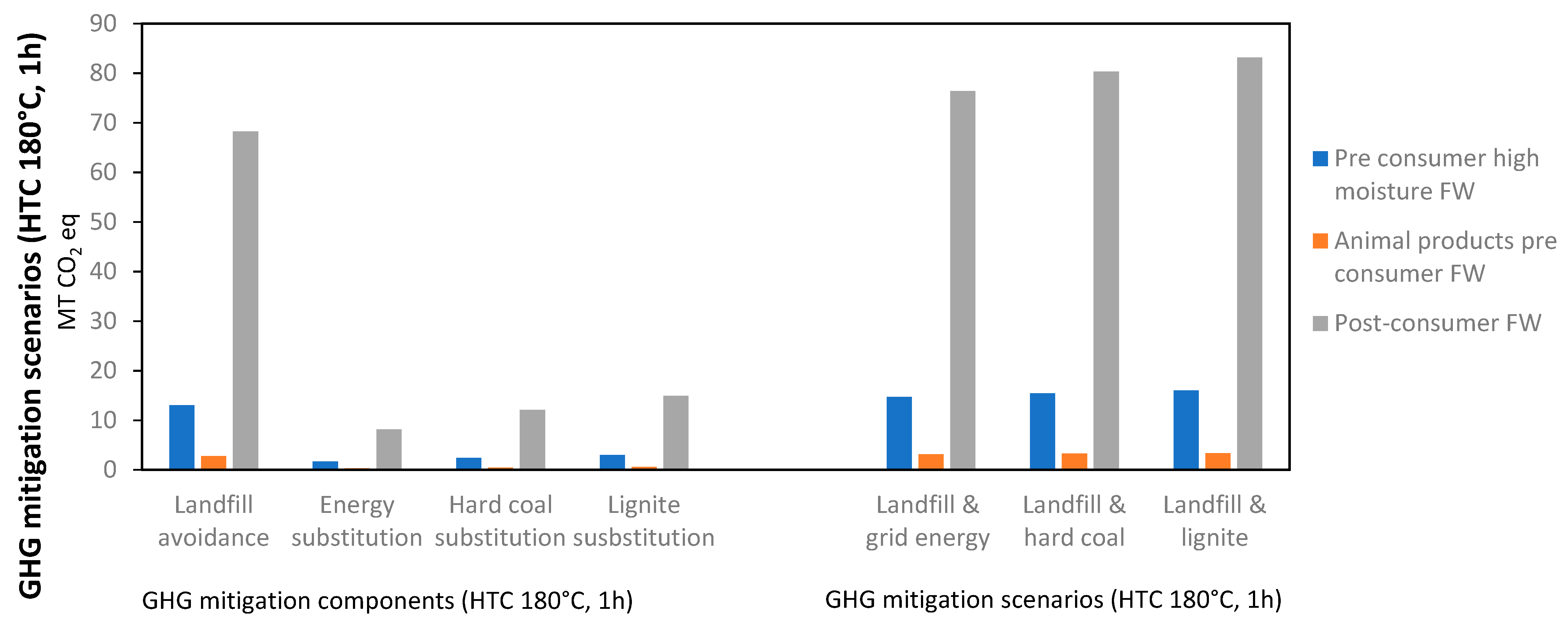
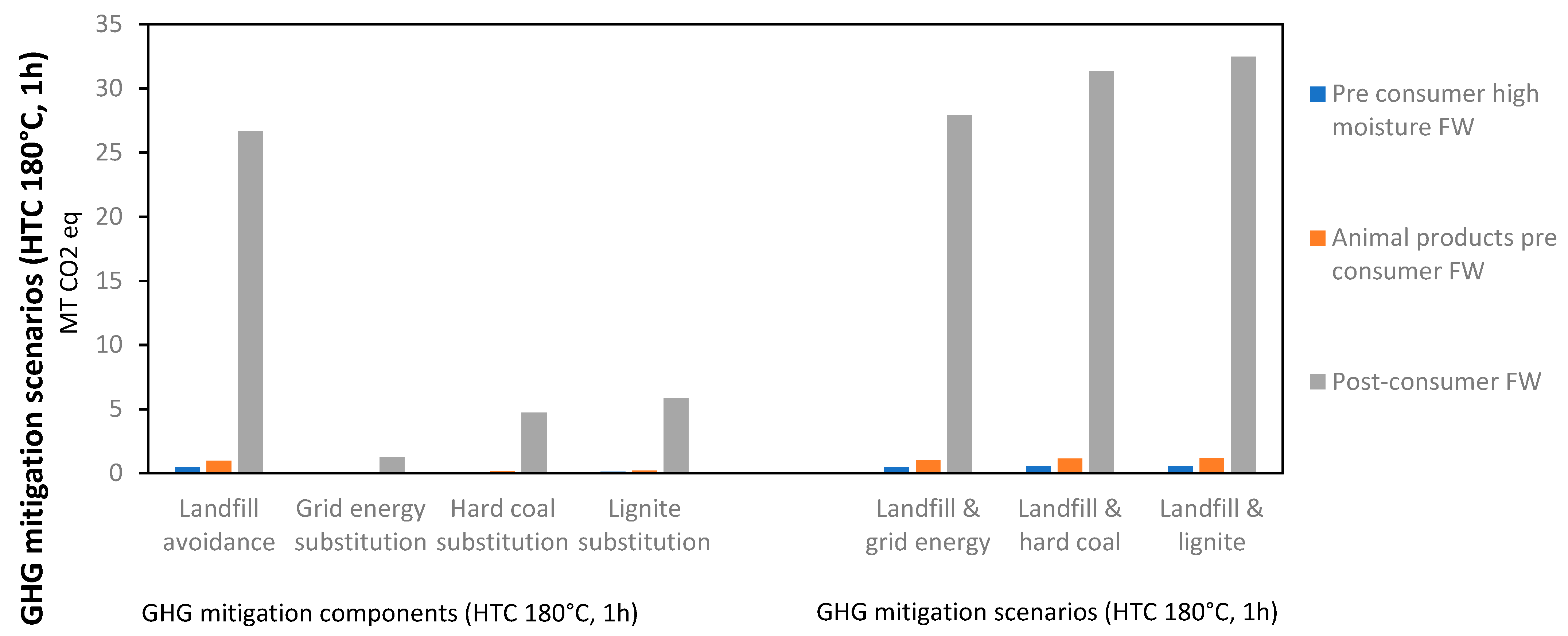
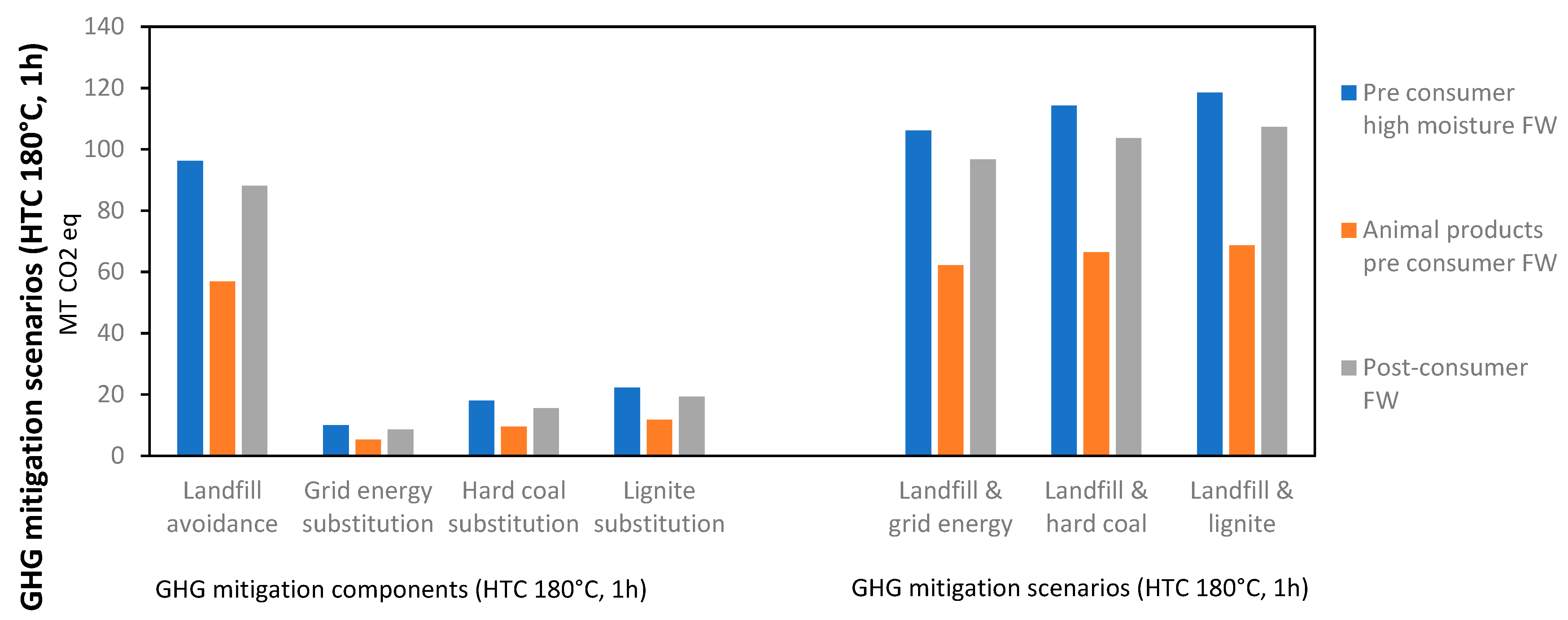

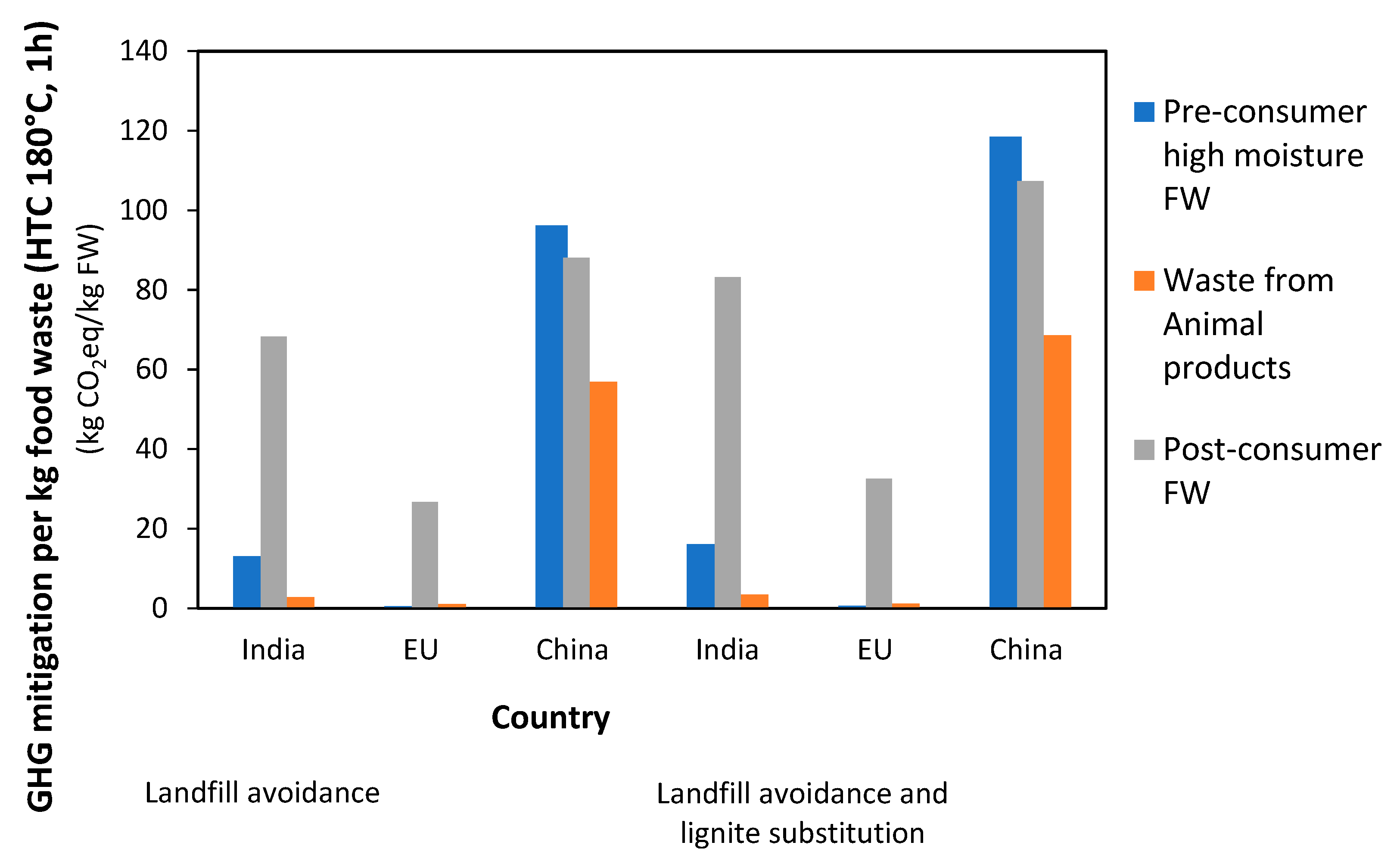
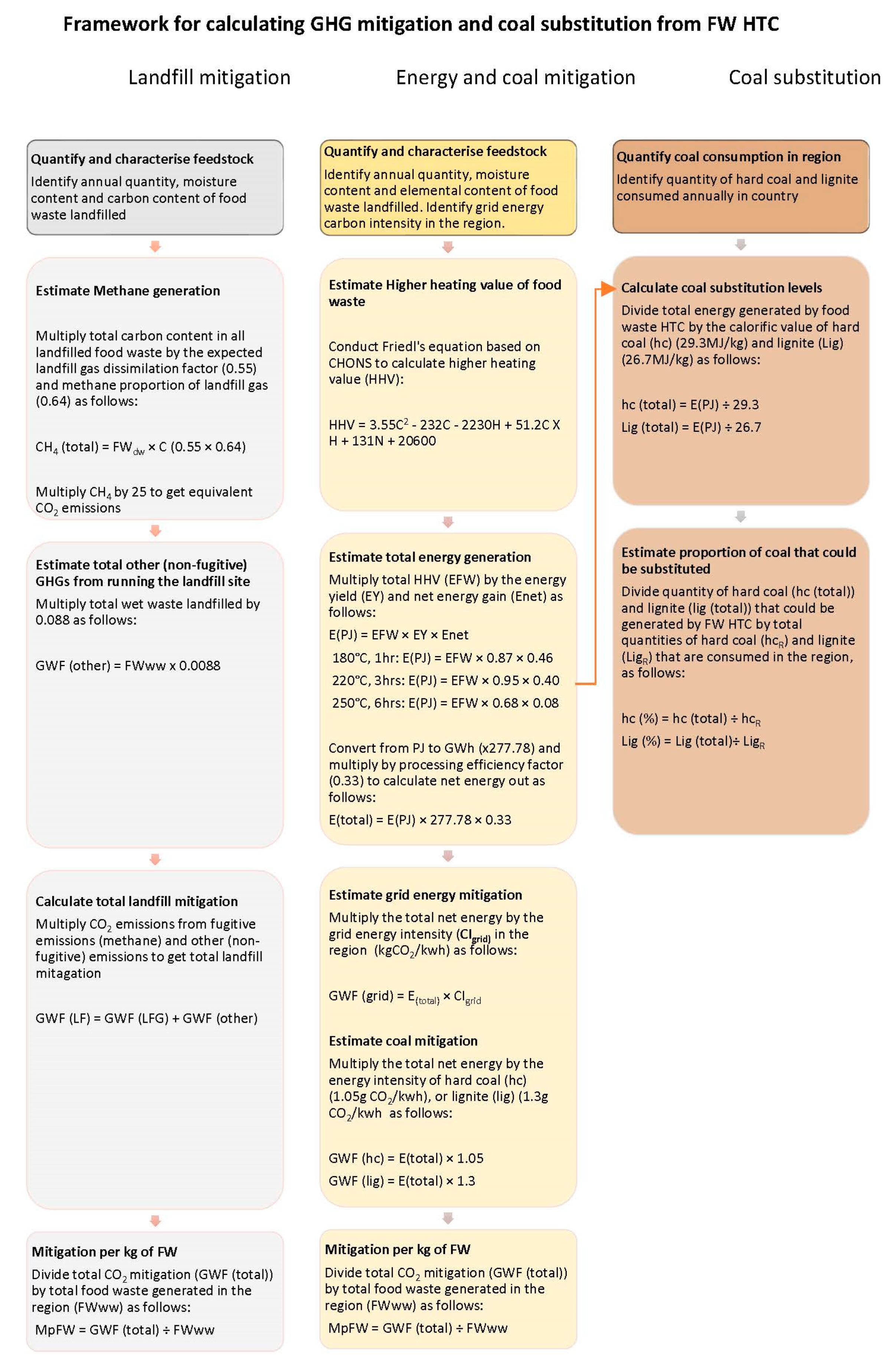
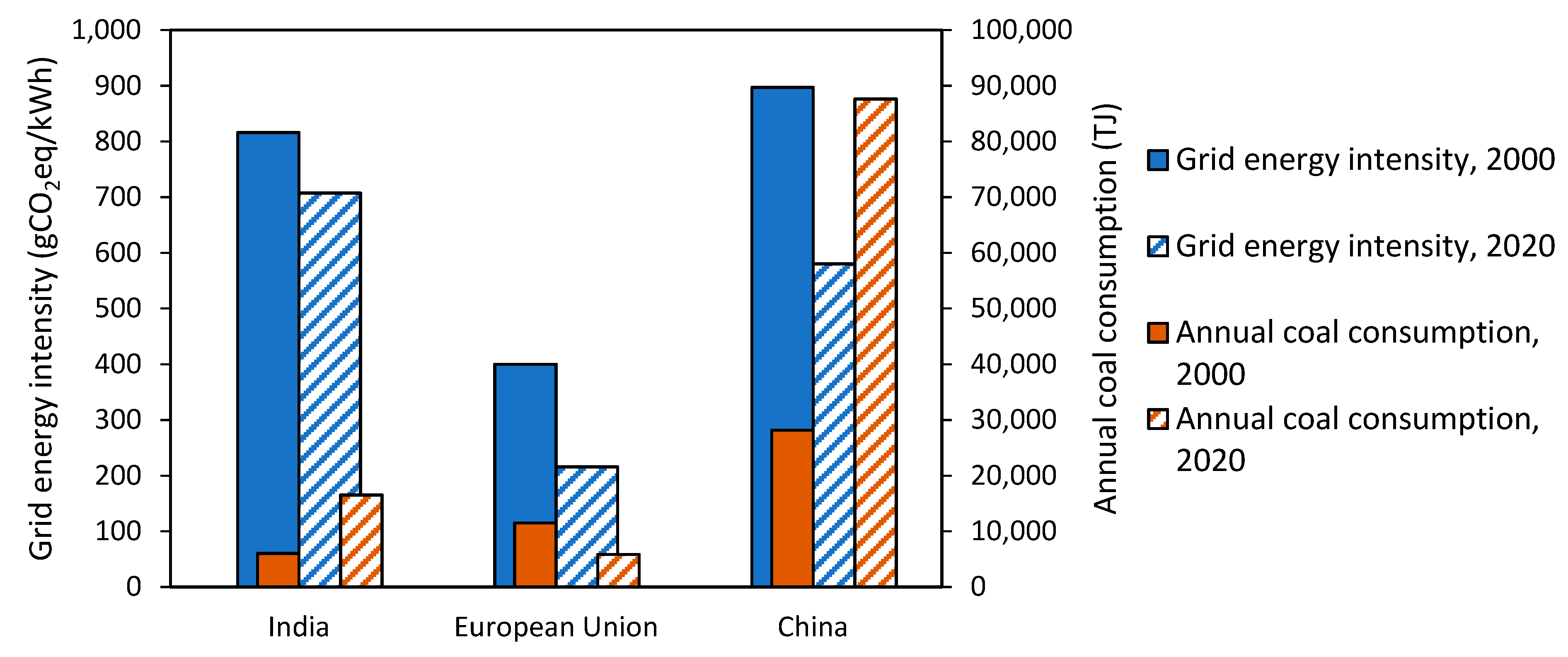
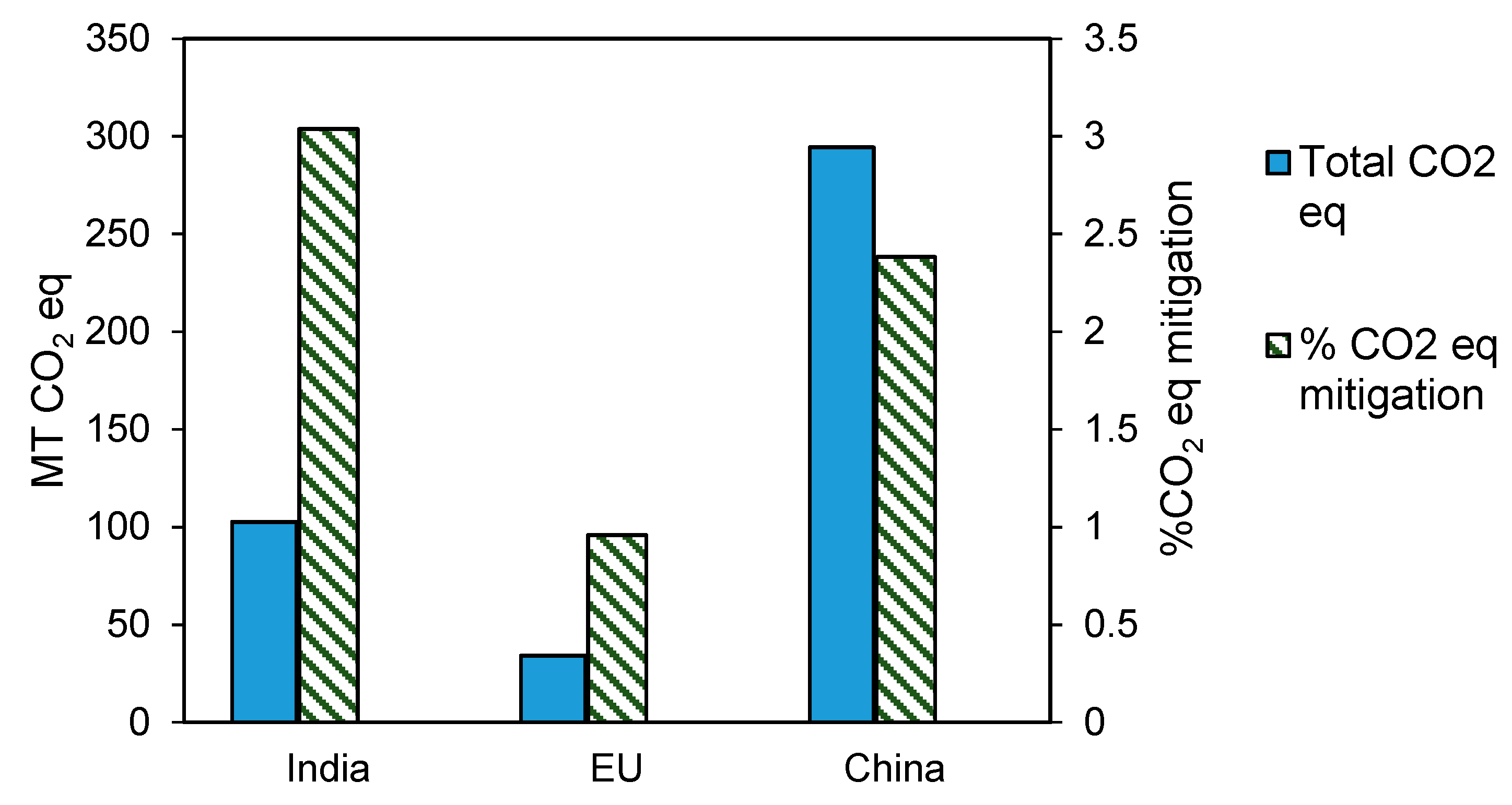
| Mitigation Type | HTC Type | High Moisture pre Consumer FW | Animal Products pre Consumer FW | Post-Consumer FW | Total | ||||
|---|---|---|---|---|---|---|---|---|---|
| Unit Measurements GHG Mitigation Components | MT CO2 eq | kg CO2 eq/kg FW | MT CO2 eq | kg CO2 eq/kg FW | MT CO2 eq | kg CO2 eq/kg FW | MT CO2 eq | kg CO2 eq/kg FW | |
| Landfill avoidance | 13.02 | 0.92 | 2.78 | 1.80 | 68.23 | 0.99 | 84.04 | 1.00 | |
| Energy substitution | 180 °C, 1 h | 1.64 | 0.12 | 0.31 | 0.20 | 8.12 | 0.12 | 10.07 | 0.12 |
| 220 °C, 3 h | 1.55 | 0.11 | 0.30 | 0.19 | 7.68 | 0.11 | 9.53 | 0.11 | |
| 250 °C, 6 h | 0.23 | 0.02 | 0.04 | 0.03 | 1.14 | 0.02 | 1.42 | 0.02 | |
| Hard coal substitution | 180 °C, 1 h | 2.43 | 0.17 | 0.46 | 0.30 | 12.06 | 0.18 | 14.96 | 0.18 |
| 220 °C, 3 h | 2.30 | 0.16 | 0.44 | 0.28 | 11.41 | 0.17 | 14.15 | 0.17 | |
| 250 °C, 6 h | 0.34 | 0.02 | 0.07 | 0.04 | 1.70 | 0.02 | 2.10 | 0.02 | |
| Lignite substitution | 180 °C, 1 h | 3.01 | 0.21 | 0.57 | 0.37 | 14.92 | 0.22 | 18.51 | 0.22 |
| 220 °C, 3 h | 2.85 | 0.20 | 0.54 | 0.35 | 14.12 | 0.21 | 17.51 | 0.21 | |
| 250 °C, 6 h | 0.42 | 0.03 | 0.08 | 0.05 | 2.10 | 0.03 | 2.60 | 0.03 | |
| GHG mitigation scenarios Landfill and energy substitution | 180 °C, 1 h | 14.66 | 1.04 | 3.10 | 2.00 | 76.36 | 1.11 | 94.11 | 1.12 |
| 220 °C, 3 h | 14.57 | 1.03 | 3.08 | 1.99 | 75.92 | 1.10 | 93.57 | 1.11 | |
| 250 °C, 6 h | 13.25 | 0.94 | 2.83 | 1.83 | 69.38 | 1.01 | 85.46 | 1.01 | |
| Landfill and hard coal substitution | 180 °C, 1 h | 15.45 | 1.10 | 3.25 | 2.10 | 80.29 | 1.17 | 99.00 | 1.17 |
| 220 °C, 3 h | 15.32 | 1.09 | 3.22 | 2.08 | 79.64 | 1.16 | 98.19 | 1.16 | |
| 250 °C, 6 h | 13.36 | 0.95 | 2.85 | 1.84 | 69.93 | 1.02 | 86.14 | 1.02 | |
| Landfill and lignite substitution | 180 °C, 1 h | 16.03 | 1.14 | 3.36 | 2.17 | 83.16 | 1.21 | 102.55 | 1.22 |
| 220 °C, 3 h | 15.87 | 1.13 | 3.33 | 2.15 | 82.35 | 1.20 | 101.55 | 1.20 | |
| 250 °C, 6 h | 13.44 | 0.95 | 2.87 | 1.85 | 70.33 | 1.20 | 98.66 | 1.17 | |
| Mitigation Type | HTC Type | High Moisture Pre-Consumer FW | Animal Products Pre-Consumer FW | Post-Consumer FW | Total | ||||
|---|---|---|---|---|---|---|---|---|---|
| Unit Measurements GHG Mitigation Components | MT CO2 eq | kg CO2 eq/kg FW | MT CO2 eq | kg CO2 eq/kg FW | MT CO2 eq | kg CO2 eq/kg FW | MT CO2 eq | kg CO2 eq/kg FW | |
| Landfill avoidance | 0.47 | 0.04 | 0.97 | 0.18 | 26.64 | 0.47 | 28.08 | 0.37 | |
| Energy substitution | 180 °C, 1 h | 0.02 | 0.00 | 0.04 | 0.01 | 1.23 | 0.02 | 1.30 | 0.02 |
| 220 °C, 3 h | 0.02 | 0.00 | 0.04 | 0.00 | 1.17 | 0.02 | 1.23 | 0.02 | |
| 250 °C, 6 h | 0.00 | 0.00 | 0.01 | 0.00 | 0.17 | 0.00 | 0.18 | 0.00 | |
| Hard coal substitution | 180 °C, 1 h | 0.09 | 0.01 | 0.16 | 0.03 | 4.71 | 0.08 | 4.96 | 0.07 |
| 220 °C, 3 h | 0.08 | 0.01 | 0.15 | 0.03 | 4.45 | 0.08 | 4.69 | 0.06 | |
| 250 °C, 6 h | 0.01 | 0.00 | 0.02 | 0.00 | 0.66 | 0.01 | 0.70 | 0.01 | |
| Lignite substitution | 180 °C, 1 h | 0.11 | 0.01 | 0.20 | 0.04 | 5.83 | 0.10 | 6.13 | 0.08 |
| 220 °C, 3 h | 0.10 | 0.01 | 0.19 | 0.04 | 5.51 | 0.10 | 5.80 | 0.08 | |
| 250 °C, 6 h | 0.02 | 0.00 | 0.03 | 0.01 | 0.82 | 0.01 | 0.86 | 0.01 | |
| GHG mitigation scenarios Landfill and energy substitution | 180 °C, 1 h | 0.49 | 0.04 | 1.01 | 0.19 | 27.88 | 0.49 | 29.38 | 0.39 |
| 220 °C, 3 h | 0.49 | 0.04 | 1.01 | 0.19 | 27.81 | 0.49 | 29.31 | 0.39 | |
| 250 °C, 6 h | 0.47 | 0.04 | 0.98 | 0.18 | 26.82 | 0.47 | 28.26 | 0.37 | |
| Landfill and hard coal substitution | 180 °C, 1 h | 0.55 | 0.04 | 1.13 | 0.21 | 31.35 | 0.55 | 33.04 | 0.44 |
| 220 °C, 3 h | 0.55 | 0.04 | 1.12 | 0.21 | 31.10 | 0.55 | 32.77 | 0.43 | |
| 250 °C, 6 h | 0.48 | 0.04 | 0.99 | 0.19 | 27.31 | 0.48 | 28.78 | 0.38 | |
| Landfill and lignite substitution | 180 °C, 1 h | 0.57 | 0.04 | 1.17 | 0.22 | 32.47 | 0.57 | 34.21 | 0.45 |
| 220 °C, 3 h | 0.57 | 0.04 | 1.16 | 0.22 | 32.16 | 0.56 | 33.88 | 0.45 | |
| 250 °C, 6 h | 0.48 | 0.04 | 1.00 | 0.19 | 27.46 | 0.48 | 28.94 | 0.38 | |
| Mitigation Type | HTC Type | High Moisture pre Consumer FW | Animal Products pre Consumer FW | Post-Consumer FW | Total | ||||
|---|---|---|---|---|---|---|---|---|---|
| Unit Measurements GHG Mitigation Components | MT CO2 eq | kg CO2 eq/kg FW | MT CO2 eq | kg CO2 eq/kg FW | MT CO2 eq | kg CO2 eq/kg FW | MT CO2 eq | kg CO2 eq/kg FW | |
| Landfill avoidance | 96.20 | 0.48 | 56.87 | 0.94 | 88.06 | 0.52 | 241.12 | 0.56 | |
| Energy substitution | 180 °C, 1 h | 9.94 | 0.05 | 5.24 | 0.09 | 8.60 | 0.05 | 23.77 | 0.06 |
| 220 °C, 3 h | 9.40 | 0.05 | 4.95 | 0.08 | 8.13 | 0.05 | 22.48 | 0.05 | |
| 250 °C, 6 h | 1.40 | 0.01 | 0.74 | 0.02 | 0.94 | 0.09 | 3.07 | 0.04 | |
| Hard coal substitution | 180 °C, 1 h | 17.99 | 0.09 | 9.48 | 0.16 | 15.56 | 0.09 | 43.03 | 0.10 |
| 220 °C, 3 h | 17.02 | 0.09 | 8.97 | 0.15 | 14.72 | 0.09 | 40.70 | 0.09 | |
| 250 °C, 6 h | 2.53 | 0.01 | 1.33 | 0.04 | 1.70 | 0.17 | 5.56 | 0.08 | |
| Lignite substitution | 180 °C, 1 h | 22.26 | 0.11 | 11.73 | 0.19 | 19.26 | 0.11 | 53.25 | 0.12 |
| 220 °C, 3 h | 21.06 | 0.11 | 11.10 | 0.18 | 18.22 | 0.11 | 50.37 | 0.12 | |
| 250 °C, 6 h | 3.13 | 0.01 | 1.65 | 0.05 | 2.10 | 0.21 | 6.88 | 0.10 | |
| GHG mitigation scenarios Landfill and energy substitution | 180 °C, 1 h | 106.14 | 0.53 | 62.11 | 1.02 | 96.65 | 0.57 | 264.89 | 0.62 |
| 220 °C, 3 h | 105.60 | 0.53 | 61.82 | 1.02 | 96.19 | 0.57 | 263.61 | 0.61 | |
| 250 °C, 6 h | 97.60 | 0.49 | 57.61 | 0.95 | 88.99 | 0.52 | 244.20 | 0.57 | |
| Landfill and hard coal substitution | 180 °C, 1 h | 114.19 | 0.57 | 66.35 | 1.09 | 103.62 | 0.61 | 284.16 | 0.66 |
| 220 °C, 3 h | 113.22 | 0.57 | 65.84 | 1.09 | 102.78 | 0.60 | 281.83 | 0.66 | |
| 250 °C, 6 h | 98.73 | 0.49 | 58.20 | 0.96 | 89.75 | 0.53 | 246.68 | 0.57 | |
| Landfill and lignite substitution | 180 °C, 1 h | 118.46 | 0.59 | 68.60 | 1.13 | 107.31 | 0.63 | 294.38 | 0.68 |
| 220 °C, 3 h | 117.26 | 0.59 | 67.97 | 1.12 | 106.27 | 0.63 | 291.50 | 0.68 | |
| 250 °C, 6 h | 99.33 | 0.50 | 58.52 | 0.97 | 90.15 | 0.53 | 248.01 | 0.58 | |
| Category | HTC Type | High Moisture Pre-Consumer FW | Waste from Animal Products | Post-Consumer FW | Total | |||||
|---|---|---|---|---|---|---|---|---|---|---|
| Unit Measurements | Total Substitution (MT) | Proportion of Coal (%) | Total Substitution (MT) | Proportion of Coal (%) | Total Substitution (MT) | Proportion of Coal (%) | Total Substitution (MT) | Proportion of Coal (%) | ||
| India | Hard coal | 180 °C, 1 h | 0.86 | 0.11 | 0.16 | 0.02 | 0.60 | 0.53 | 5.30 | 0.66 |
| 220 °C, 3 h | 0.82 | 0.10 | 0.16 | 0.02 | 0.60 | 0.50 | 5.02 | 0.62 | ||
| 250 °C, 6 h | 0.12 | 0.02 | 0.02 | 0.00 | 0.60 | 0.07 | 0.75 | 0.09 | ||
| Lignite | 180 °C, 1 h | 0.95 | 2.02 | 0.18 | 0.38 | 4.69 | 9.98 | 5.82 | 12.38 | |
| 220 °C, 3 h | 0.90 | 1.91 | 0.17 | 0.36 | 4.44 | 9.44 | 5.51 | 11.71 | ||
| 250 °C, 6 h | 0.13 | 0.28 | 0.03 | 0.05 | 0.66 | 1.40 | 0.82 | 1.74 | ||
| EU | Hard coal | 180 °C, 1 h | 0.03 | 0.02 | 0.06 | 0.04 | 1.67 | 1.16 | 1.76 | 1.22 |
| 220 °C, 3 h | 0.03 | 0.02 | 0.05 | 0.04 | 1.58 | 1.10 | 1.66 | 1.15 | ||
| 250 °C, 6 h | 0.00 | 0.00 | 0.01 | 0.01 | 0.23 | 0.16 | 0.25 | 0.17 | ||
| Lignite | 180 °C, 1 h | 0.03 | 0.01 | 0.06 | 0.03 | 1.83 | 0.74 | 1.93 | 0.78 | |
| 220 °C, 3 h | 0.03 | 0.01 | 0.06 | 0.02 | 1.73 | 0.70 | 1.82 | 0.74 | ||
| 250 °C, 6 h | 0.00 | 0.00 | 0.01 | 0.00 | 0.26 | 0.10 | 0.27 | 0.11 | ||
| China | Hard coal | 180 °C, 1 h | 6.38 | 0.21 | 3.36 | 0.11 | 5.52 | 0.18 | 15.26 | 0.51 |
| 220 °C, 3 h | 6.03 | 0.20 | 3.18 | 0.11 | 5.22 | 0.17 | 14.43 | 0.48 | ||
| 250 °C, 6 h | 0.90 | 0.03 | 0.47 | 0.02 | 0.60 | 0.02 | 1.97 | 0.07 | ||
| Lignite | 180 °C, 1 h | 7.00 | 2.97 | 3.69 | 1.56 | 6.06 | 2.57 | 16.74 | 7.10 | |
| 220 °C, 3 h | 6.62 | 2.81 | 3.49 | 1.48 | 5.73 | 2.43 | 15.84 | 6.71 | ||
| 250 °C, 6 h | 0.98 | 0.42 | 0.52 | 0.22 | 0.66 | 0.28 | 2.16 | 0.92 | ||
| Category | High Moisture Pre-Consumer FW | Waste from Animal Products | Post-Consumer FW | Total | ||||
|---|---|---|---|---|---|---|---|---|
| Unit Measurements | Total Substitution (MT) | Proportion of Methane (%) | Total Substitution (MT) | Proportion of Methane (%) | Total Substitution (MT) | Proportion of Methane (%) | Total Substitution (MT) | Proportion of Methane (%) |
| India | 0.52 | 1.94 | 0.11 | 0.42 | 2.71 | 10.17 | 3.34 | 12.52 |
| EU | 0.02 | 0.12 | 0.04 | 0.25 | 1.06 | 6.87 | 1.12 | 7.24 |
| China | 3.82 | 7.70 | 2.27 | 4.57 | 3.50 | 7.05 | 9.58 | 19.32 |
Publisher’s Note: MDPI stays neutral with regard to jurisdictional claims in published maps and institutional affiliations. |
© 2022 by the authors. Licensee MDPI, Basel, Switzerland. This article is an open access article distributed under the terms and conditions of the Creative Commons Attribution (CC BY) license (https://creativecommons.org/licenses/by/4.0/).
Share and Cite
Davison, N.; Borbolla Gaxiola, J.; Gupta, D.; Garg, A.; Cockerill, T.; Tang, Y.; Yuan, X.; Ross, A. Potential Greenhouse Gas Mitigation for Converting High Moisture Food Waste into Bio-Coal from Hydrothermal Carbonisation in India, Europe and China. Energies 2022, 15, 1372. https://doi.org/10.3390/en15041372
Davison N, Borbolla Gaxiola J, Gupta D, Garg A, Cockerill T, Tang Y, Yuan X, Ross A. Potential Greenhouse Gas Mitigation for Converting High Moisture Food Waste into Bio-Coal from Hydrothermal Carbonisation in India, Europe and China. Energies. 2022; 15(4):1372. https://doi.org/10.3390/en15041372
Chicago/Turabian StyleDavison, Nicholas, Jaime Borbolla Gaxiola, Divya Gupta, Anurag Garg, Timothy Cockerill, Yuzhou Tang, Xueliang Yuan, and Andrew Ross. 2022. "Potential Greenhouse Gas Mitigation for Converting High Moisture Food Waste into Bio-Coal from Hydrothermal Carbonisation in India, Europe and China" Energies 15, no. 4: 1372. https://doi.org/10.3390/en15041372





